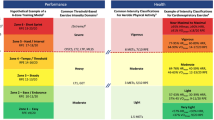Abstract
Adaptation to physical loads elicits pronounced anti-ischemic and antireperfusion effects on the isolated heart. By the 20th min of total ischemia contracture in the hearts of adapted animals is much less than that in the control group. During reperfusion of hearts from adapted animals the degree of restoration of the contractile force was 6-fold higher, contracture was lesser, and the total period of tachycardia and fibrillation were 3-fold shorter than in the control.
Similar content being viewed by others
References
N. B. Zimkin and A. V. Korobkov,Theory and Practice of Physical Culture, No 4, 270–275 (1960).
S. P. Letunov, F. A. Iordanskaya, and O. R. Nemirovich-Danchenko,, No 10, 30–33 (1972).
G. I. Markovskaya, T. F. Shevchenko, O. N. Lyubimtseva, and S. I. Shaginova,Kardiologiya, No 5, 77–80 (1973).
F. Z. Meerson and V. V. Malyshev,, No 2, 74–77 (1985).
F. Z. Meerson and M. G. Pshennikova,Adaptation to Stress Situations and Physical Loads [in Russian], Moscow (1988).
F. Z. Meerson and V. Yu. Malyshev,The Phenomenon of Adaptational Stabilization of Structures and Heart Protection [in Russian], Moscow (1993).
Yu. N. Trifonov, in:Annals of the Leshaf Institute of Physical Culture and Sports [in Russian], (1959), pp. 38–47.
E. S. Troshanova,Byull. Eksp. Biol. Med.,32, No 10, 283–287 (1951).
M. M. Bersohn and J. Scheuer,Amer. J. Physiol.,234, H215-H218 (1978).
S. R. Bloom, R. H. Johnson, D. M. Park,et al., J. Physiol. (Lond.),258, 1–18 (1976).
H. Gurki, F. Z. Meerson, and G. Wassilew,Exp. Pathol.,20, 108–120 (1981).
J. E. Koerner and R. L. Terjung,J. Appl. Physiol.,52, 376–387 (1982).
T. D. Noakes, L. Higginson, and L. H. Opie,Circulation,67, 24–30 (1983).
S. Penpargkul, A. Schwartz, and J. Scheuer,,54, Suppl. 2, 114 (1976).
A. Quantanilha,Biochem. Soc. Trans.,12, No 3, 403 (1984).
L. D. Segel and D. T. Mason,J. Appl. Physiol.,44, 183–189 (1978).
W. W. Winder, R. C. Hickson, J. M. Hagberg,et al.,,46, 766–771 (1979).
Author information
Authors and Affiliations
Additional information
Translated fromByulleten' Eksperimental'noi Biologii i Meditsiny, Vol. 119, No 1, pp. 25–27, January, 1995
Rights and permissions
About this article
Cite this article
Malyshev, I.Y., Prodius, P.A. & Meerson, F.Z. Effect of adaptation to moderate physical loads on the increased resistance of the isolated heart to ischemia and reperfusion. Bull Exp Biol Med 119, 20–22 (1995). https://doi.org/10.1007/BF02445920
Received:
Issue Date:
DOI: https://doi.org/10.1007/BF02445920




